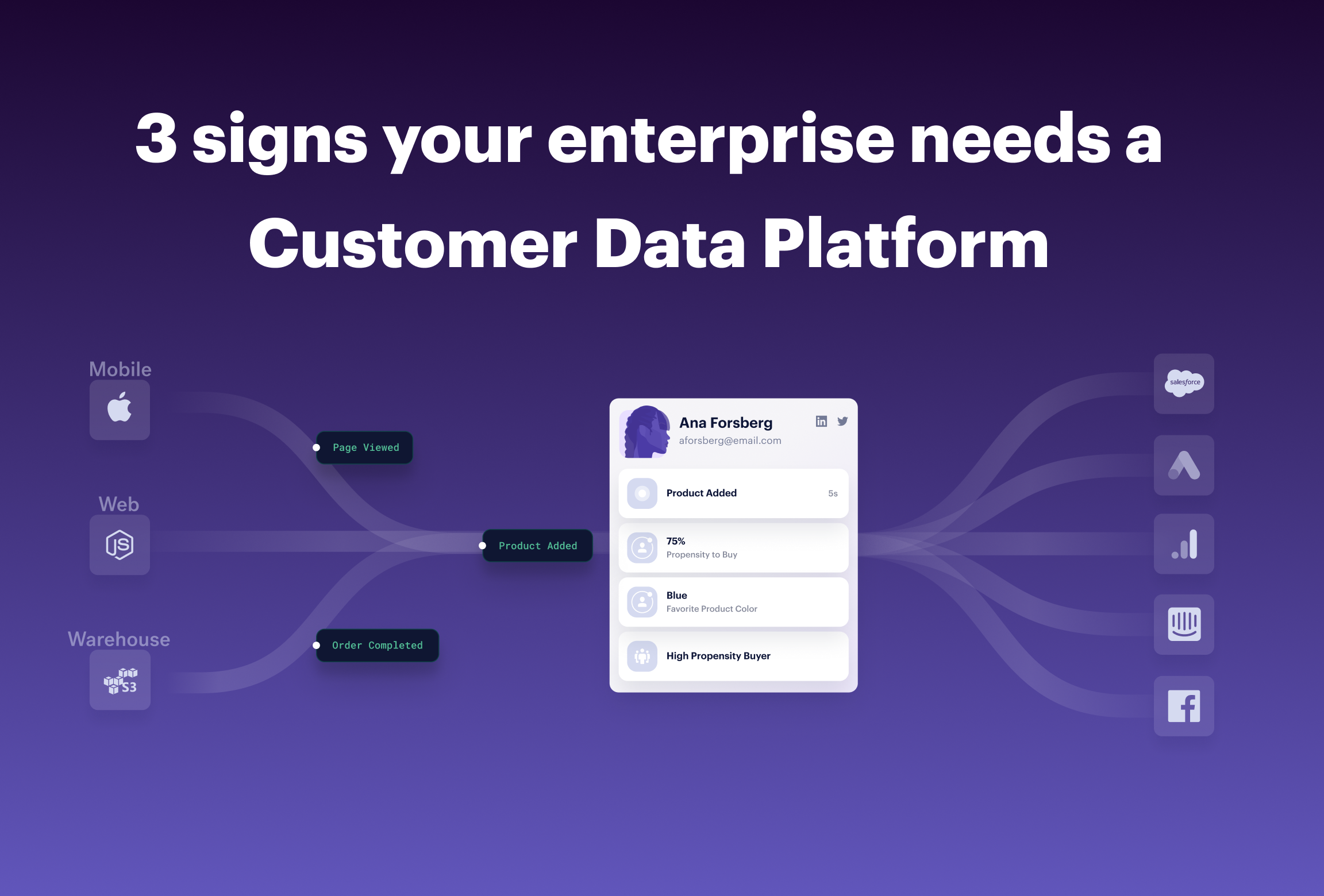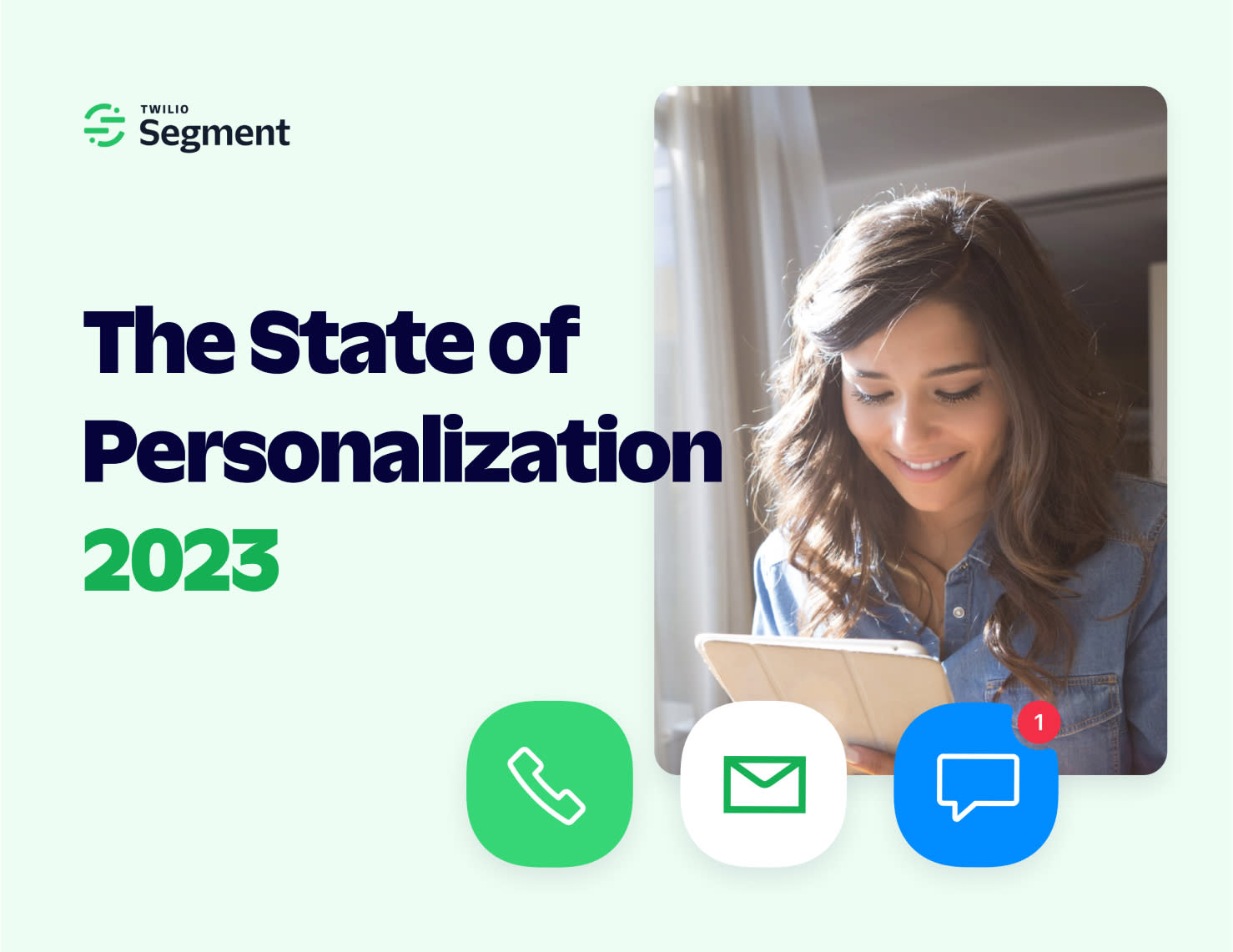3 signs your enterprise needs a CDP
Three common warning signs that your enterprise needs a Customer Data Platform
Nov 23, 2020
By Nicole Nearhood
Our world has become more digital than ever—and there’s no end in sight. In this current market, it’s no longer a point of debate whether customer data is essential or not. The new discussion is how enterprises are supposed to tackle modern digital experiences and handle the enormous volumes of customer data generated as a result.
Enterprises are navigating the complexities of data flowing in from numerous brands and customers by using a customer data platform (CDP). After working with hundreds of enterprises, we’ve identified three common warning signs that highlight it’s time to better harness the power of your customer data by investing in a CDP.
If your enterprise is struggling to bring data together, identify your most loyal customers, or make data-driven decisions, it’s time to consider a CDP.

Sign #1: You struggle to bring data together
Whether your business is just getting started with digital or doubling down, every move you make requires connecting some data from various data sources to the places you need it. Most enterprises are currently facing a challenge to keep all of this information integrated, standardized, and clean so you can actually solve customer experience problems.
Without a central place for your customer data, you are required to connect different data islands and hope that it all comes together—and this becomes more difficult and time-consuming as you continue growing and adding new tools to your stack. At this point, you aren’t addressing business problems or customer experiences. You’re mostly spending time and energy figuring out what you know and whether you can trust that data.
A CDP helps alleviate this problem by making it possible to bring customer data together while minimizing redundancy and complexity. Neel Adhya, Chief Digital Officer of IBM Cloud, describes how his team handled managing enormous volumes of data using Segment:
"We have vast volumes of data. Data coming at you in high velocity. I know teams can feel overwhelmed by it. At a large company like IBM, you will have marketing data, sales data, product data, support, and CS data. For us, the design of the tech stack and the role of the CDP is to bring all of that data together at the moments of truth so we can drive a superior customer experience." -Neel Adhya, IBM
You’ll never invest in large-scale marketing or customer campaigns if you can’t trust the data underneath the surface. And you also shouldn’t be wasting valuable technical time and resources exclusively on the data connections. If you’re spending too much time on this problem, you should consider a CDP.
Sign #2: You can’t identify your most loyal customers
At large enterprises that house many brands, it can be challenging to identify your most loyal customers across the entire portfolio. This is especially true at enterprises where data and tech stacks are siloed within each brand and disconnected tools aren’t talking to each other. This is a problem because your most loyal customers are often your most valuable customers, since they are more likely to come back for repeat business across brands.
To truly understand who your best customers are and what makes them tick, you need clean customer data at the enterprise-wide level. However, to create a unified view of your customers you must make requests from multiple teams, learn new tools, build manual integrations, create new workflows, face backlogs and delays, bugs, and other roadblocks. Manually integrating siloed data to identify your most valuable users is painful and time consuming.
Fox, which has millions of digital users across 30+ applications and websites, solved this challenge with a CDP. Fox uses Segment to collect customer data across all of their channels and properties to create a singular view of the customer. Daryl Bowden, Senior Vice President of Technology at Fox Corporation explains:
"At Fox we have to collect the data in the same way so that when you bring it together, it’s useful. Now that we have all that data in one unified place, Segment, we can make decisions, improve products, and treat users the way they want to be treated." -Daryl Bowden, Fox Corporation
If you’re having a hard time identifying your most profitable, cross-brand customers and creating the digital experiences that nurture those relationships and drive repeat business, you should consider a CDP.
Sign #3: Your digital experiences are based on gut decisions
Enterprises must create hundreds, even thousands, of digital experiences across the customer journey. It’s well known that using data to guide digital experience decisions is more effective than using gut feelings. Still, it can feel overwhelming to do that for every customer touchpoint across brands, channels, and devices.
If this sounds familiar, your team may be using data to drive some digital experience decisions, but they likely can’t be as agile as they need to be if data is difficult to access. Without a customer data platform, many digital experiences are likely to be created based on gut simply because your customer data is hard to use. Marketing teams hit bottlenecks when gathering data from disparate sources and when trying to activate that data in the downstream tools they use to create emails, advertising, or other customer communications. Inaccessible data results in unoptimized user journeys, wasted advertising dollars, and frustrated teams.
Our own customer facing teams at Segment solve this challenge by using Segment to create dynamic customer profiles that can be used to create the right digital experiences. These profiles empower our marketing, customer success, and product teams to quickly make data-driven decisions and build the experiences customers want. John Hermansen, Segment’s Head of Demand Generation and Growth shares how Segment has changed the game:
"We’re able to do things today that just a couple of years ago I wouldn’t have dreamed of. We’re able to take advantage of customer attributes and behavioral data to customize emails, optimize advertising spend, and improve customer success." -John Hermansen, Segment
If your teams launch digital experiences based on gut because your customer data is not easily accessed, you should consider a CDP.
It’s the right time to act
Collecting, standardizing, and activating good customer data is vital to creating digital experiences that drive results. However, more data isn’t going to get you there unless you can manage it effectively. IBM and Fox successfully implemented a centralized data infrastructure with Segment at the core. Segment now enables them to more effectively manage their vast volumes of customer data and quickly turn that data into better digital experiences.
If you’re an enterprise wondering how a CDP could help you, start here by testing your customer data maturity or request a demo to speak to a Segment expert.
To learn more about how IBM is scaling their data strategy, watch their panel on-demand via our CDP Week portal. To learn how Fox delivers superior experiences while protecting customer privacy, watch this short video presentation.
The State of Personalization 2023
Our annual look at how attitudes, preferences, and experiences with personalization have evolved over the past year.
Get the report
The State of Personalization 2023
Our annual look at how attitudes, preferences, and experiences with personalization have evolved over the past year.
Get the report
Share article
Recommended articles
How to accelerate time-to-value with a personalized customer onboarding campaign
To help businesses reach time-to-value faster, this blog explores how tools like Twilio Segment can be used to customize onboarding to activate users immediately, optimize engagement with real-time audiences, and utilize NPS for deeper customer insights.
Introducing Segment Community: A central hub to connect, learn, share and innovate
Dive into Segment's vibrant customer community, where you can connect with peers, gain exclusive insights, and elevate your success with expert guidance and resources!
Using ClickHouse to count unique users at scale
By implementing semantic sharding and optimizing filtering and grouping with ClickHouse, we transformed query times from minutes to seconds, ensuring efficient handling of high-volume journeys in production while paving the way for future enhancements.